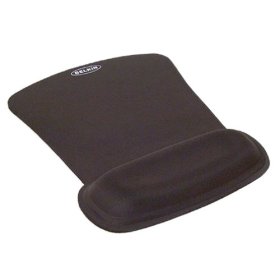How to avoid some pain at working at a desk for hours and hours
So lately I've decided that my computer posture is abysmal, often leaving my shoulder, especially my right one, throbbing with ache. But now, I've finally done something about it. Several things in fact:
- Get a mouse pad with a wrist rest. This is the single most important thing that alleviated my shoulder pains. I realized that before, I was manipulating the mouse as a whole arm movement. Moving the mouse means that I must be able to move my hand freely. Without a wrist pad, this required moving my whole right arm, starting with the shoulder. The longer I use my mouse, the more I work my shoulder, driving it into oblivion at the end of the day. In order to use the mouse without straining my shoulder, I need a mouse-pad with a wrist pad.
I can then rest my wrist or the base of my hand on the wrist pad, thereby letting my upper arm rest immobile with no strain. All manipulation of the mouse is done with the hands, leaving my shoulder relaxed.
-
I've only tried it a few times, but this also sounds pretty good: swap your mouse hand occasionally. I have one friend who swaps it every week and another friend who swaps hand between work and home.
-
I bought an external monitor. At home, I typically plonk my Macbook on my desk. Then I crane my neck downwards onto the notebook screen, thereby working all the muscles in my shoulder. There are two solutions to avoid this. One is to buy a rack for my Macbook: ugly. The other solution, is to buy an external monitor that rises up to near eye-level. In my case, I went for a gorgeous, and reasonably affordable, 22" HP wide-screen monitor.
This had an added benefit: combine this with my Harman-Kardon Soundsticks, and the soft silky images fill up the room and watching movies in my room is now an A+ experience. It's sick.
-
I've started doing shoulder stretches periodically. I never knew such exercises existed until my friend Hua Feng told me. It's simple: grab a towel or a sweater and hold it stretched above your head with both hands, stretched as far out as possible. Then bend the towel as far behind your head as possible, and hold it. Repeat 10-20 times. Your shoulder should feel nice and stretched.
-
Read standing up. I realize half the problem is that I'm sitting too much during the day. I don't think we're physiologically designed to be so sedentary. Yet if we want to put in a good day's work, we need to be at least near a computer. However, even when I am working hard, I am not actually coding or writing all the time. Often, I am just reading – books, articles, my scribbled notes. Then I figured out that I can read just as well standing up as I do sitting down. I can even pace around the lab while I'm reading.
There's an added benefit to standing up. The guru of self-experimentation Seth Roberts has recently written a number of interesting posts on things that help him sleep soundly at night. Surprisingly, he's discovered that standing till your legs get exhausted seems to be the one thing that provokes his body into falling into a deep satisfying sleep. His proposal is to stand on one leg for several minutes until it gets exhausted, and to repeat several times, swapping legs. This makes a lot of sense to me. In the context of avoiding the hunched over reading position that I often take when reading on my books, may I suggest that you spend part of the day standing and reading until your legs get sore. This should help you sleep well at night.

